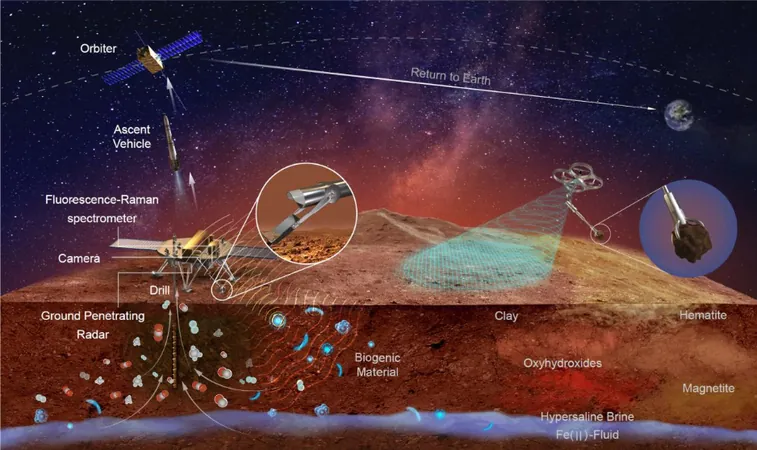
China's Bold Step to Uncover Mars Mysteries: HKU Astrobiologist on Tianwen-3 Mission
2025-07-09
Author: Yu
Could Life on Mars Finally Be Proven?
For over 50 years, scientists have pondered the tantalizing question: Was there ever life on Mars? With six active missions currently investigating the Red Planet—ranging from NASA's iconic rovers like Perseverance and Curiosity to China's Tianwen-1 orbiter—a new chapter in this quest is unfolding as China embarks on the ambitious Tianwen-3 sample return mission.
A Game-Changing Mission Structure
Mirroring the NASA/ESA Mars Sample Return mission, Tianwen-3 will feature two spacecraft: a lander to collect samples and an orbiter to return them to Earth. Professor Yiliang Li from the University of Hong Kong (HKU) has been appointed to lead a crucial team tasked with pinpointing the mission's landing site, specifically a region where liquid water once flowed—key for preserving potential signs of past or even present life.
The Science Behind the Mission
Professor Li, a prominent astrobiologist, has co-authored a paper outlining the mission’s objectives, recently published in Nature Astronomy. His team includes experts from prestigious agencies and institutions across China, highlighting the collaborative effort behind this groundbreaking achievement.
Mars: The Previous Frontiers of Discovery
The quest for Martian life traces back to NASA's Viking missions, which once scoured locations believed to have housed ancient oceans. Despite inconclusive findings, the search has intensified thanks to newer ventures like Curiosity and Perseverance.
Unlocking Earth’s Secrets Through Mars
Astrobiological work has also gained momentum with discoveries on Earth that suggest life might have emerged in our oceans over 4 billion years ago. During Mars' distant past, conditions parallel to Earth's ideal for life existed, presenting a tantalizing possibility that life could have arisen independently on the Red Planet.
Sampling for Life
The heart of the Tianwen-3 mission lies in gathering samples from areas rich in water-related minerals. The meticulous process involves drilling down 2 meters to ensure the collection of organic materials, securing them from harmful radiation and toxic elements that could obscure potential biosignatures.
Safeguarding Against Contamination
Following strict planetary protection protocols, scientists propose establishing a Mars Sample Laboratory in Hefei, China. This facility will be equipped for thorough analysis of the samples while ensuring they are contained safely, with processes in place to prevent any contamination from earthly biological agents.
A New Era for Space Exploration
With the cancellation of NASA's Mars Sample Return mission, China's Tianwen-3 mission stands poised to make history as the first to bring Martian samples back to Earth, possibly containing organic matter—or even life itself! Following the success of Tianwen-1, which accomplished a historic trifecta of orbiting, landing, and deploying the Zhurong rover, China's ambitions continue to soar with a 2028 launch plan.
Looking to the Future
An announcement issued by the CNSA invited global collaboration, with final collaborations set for selection by October 2025. If all goes as planned, the anticipated return of Martian samples is expected by 2031—potentially unlocking secrets of life beyond our world.

 Brasil (PT)
Brasil (PT)
 Canada (EN)
Canada (EN)
 Chile (ES)
Chile (ES)
 Česko (CS)
Česko (CS)
 대한민국 (KO)
대한민국 (KO)
 España (ES)
España (ES)
 France (FR)
France (FR)
 Hong Kong (EN)
Hong Kong (EN)
 Italia (IT)
Italia (IT)
 日本 (JA)
日本 (JA)
 Magyarország (HU)
Magyarország (HU)
 Norge (NO)
Norge (NO)
 Polska (PL)
Polska (PL)
 Schweiz (DE)
Schweiz (DE)
 Singapore (EN)
Singapore (EN)
 Sverige (SV)
Sverige (SV)
 Suomi (FI)
Suomi (FI)
 Türkiye (TR)
Türkiye (TR)
 الإمارات العربية المتحدة (AR)
الإمارات العربية المتحدة (AR)